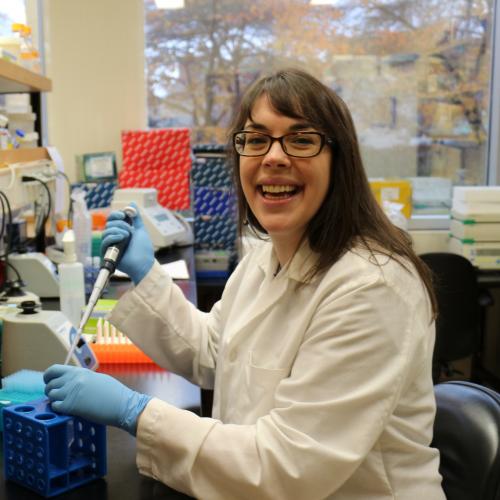Dr. Megan Levings and her team have recently published two papers on the very different functions and uses of regulatory T cells (Tregs). Tregs are immune cells that help to rein in immune responses to ensure that they don’t go too far and begin harming healthy tissues in their pursuit of foreign invaders.
A layer of tissue that’s only a single cell thick is all that that separates our intestines from the world of microbes living inside our gut. Until recently, scientists believed this layer, which is called the intestinal epithelium, was just a simple protective barrier. Thanks to work done in Dr. Bruce Vallance’s Lab at BC Children’s Hospital and elsewhere, we’re now learning that the epithelium plays a key role in human health and understanding how it works and why it fails may lead to new treatments for children with inflammatory bowel disease.
A recent paper in Trends in Immunology co-authored by Vallance lab researchers brings together significant recent developments in our understanding of the epithelium and why it’s important to our health. Dr. Vallance, UBC Postdoctoral Fellow Dr. Joannie Allaire, and UBC PhD student Shauna Crowley are co-lead authors of the paper.



“We’ve learned the epithelium is actually a key player in the gut’s immune defenses, rather than just acting as a barrier between the microbes living inside the gut and the highly reactive immune cells in the underlying tissue,” says Dr. Vallance. “It relays messages between immune cells within the intestinal tissue and the microbes outside. In this way, the microbes influence the behavior of the immune cells and vice versa.”
“We’re also discovering that the makeup of the epithelium is more complex that we previously knew,” says Dr. Allaire. “It’s not comprised of just one single cell type. There are multiple different cell types and of these cells, there are sub-types and sub-sub types.”
Researchers have found that some of the cell types in the epithelium can release cytokines, a group of proteins that play an important role in immune responses. Scientists used to believe that only immune cells could release cytokines.
These discoveries about the epithelium add to the growing understanding of our gut’s immune system and its vital role in the human body.
“Increasingly, we’re learning that the complex world of bacteria inside our guts influences human health in ways we’re only beginning to understand,” says Crowley. “By coordinating communication between immune cells and microbes, the epithelium helps control which microbes are in our guts. This makes the epithelium very important to our health.”
The Vallance Lab’s research on the epithelium also has significant implications for the understanding of Crohn’s disease and ulcerative colitis, gastrointestinal auto-inflammatory disease that are collectively known as inflammatory bowel diseases (IBD). Problems with the function of the epithelium contribute to these conditions.
Typically, in IBD, the epithelium becomes damaged, allowing immune cells and microbes to come in direct contact with each other. This triggers a strong immune response, which further damages the intestines leading to abdominal pain, fatigue, diarrhea, loss of appetite and other painful and debilitating symptoms. Many of the genetic mutations found in people with IBD affect the functions of epithelial cells, suggesting that the epithelium plays an important role in these conditions in ways that are still being understood.
“If we could find a way to repair the epithelium in children with inflammatory bowel diseases or re-introduce the signals the epithelial cells usually coordinate, we might be able to create new and more effective therapies for IBD,” says Crowley.
About 100 children are diagnosed with IBD at BC Children’s every year. Because these are chronic conditions, developing new more effective treatments is particularly important for young people who will spend the rest of their lives managing these diseases.
The current therapies for IBD often lose effectiveness over time, a particularly pressing problem for children who will need to be treated for IBD for most of their lives. These treatments also aren’t targeted, so they suppress the body’s entire immune system, not just the overactive immune response that contributes to IBD. This makes children more vulnerable to infections and certain cancers.
“Inflammatory bowel diseases are painful and can make it difficult for children to play sports, attend school and generally enjoy their childhoods,” says Dr. Allaire.
“We need to develop treatment options for these kids that work long term and don’t cause dangerous side effects. Eventually, our research may lead to new therapies that help epithelial cells work more effectively, boosting the body’s natural healing powers to treat disease.”
Every day at BC children’s Hospital, Vallance Lab researchers are studying the epithelium in hopes of contributing to new, more effective therapies for children with IBD and other gastrointestinal conditions.
Both Dr. Allaire and Crowley are studying how epithelial cells protect the body from microbes that can cause severe illness. Understanding how epithelial cells function when they’re working properly may illuminate how these cells protect against disease. Dr. Allaire is studying the molecules secreted by epithelial cells, including cytokines. Crowley looks at how epithelial cells use proteins called inflammasomes to protect the body from Salmonella bacteria. Researchers in the Vallance Lab are also studying other aspects of intestinal health, like the role microbes play in gut function and how food and nutrition contribute to healthy microbe populations.
“I’m proud that my lab has contributed to the really exciting progress we’ve made in understanding the intestinal epithelium,” says Dr. Vallance. “The epithelium is just one cell thick, but it plays a major role in our guts’ immune defenses. I look forward to continuing to explore the microscopic world of epithelial cells, so one day we and other scientists can turn this research into new therapies for kids.”
Dr. Bruce Vallance is an investigator, BC Children's Hospital; a Professor, Department of Pediatrics, University of British Columbia; and the CH.I.L.D. Foundation Chair in Pediatric Gastroenterology.
The Vallance Lab’s work is supported by the CH.I.L.D. Foundation and BC Children’s Hospital Foundation.




